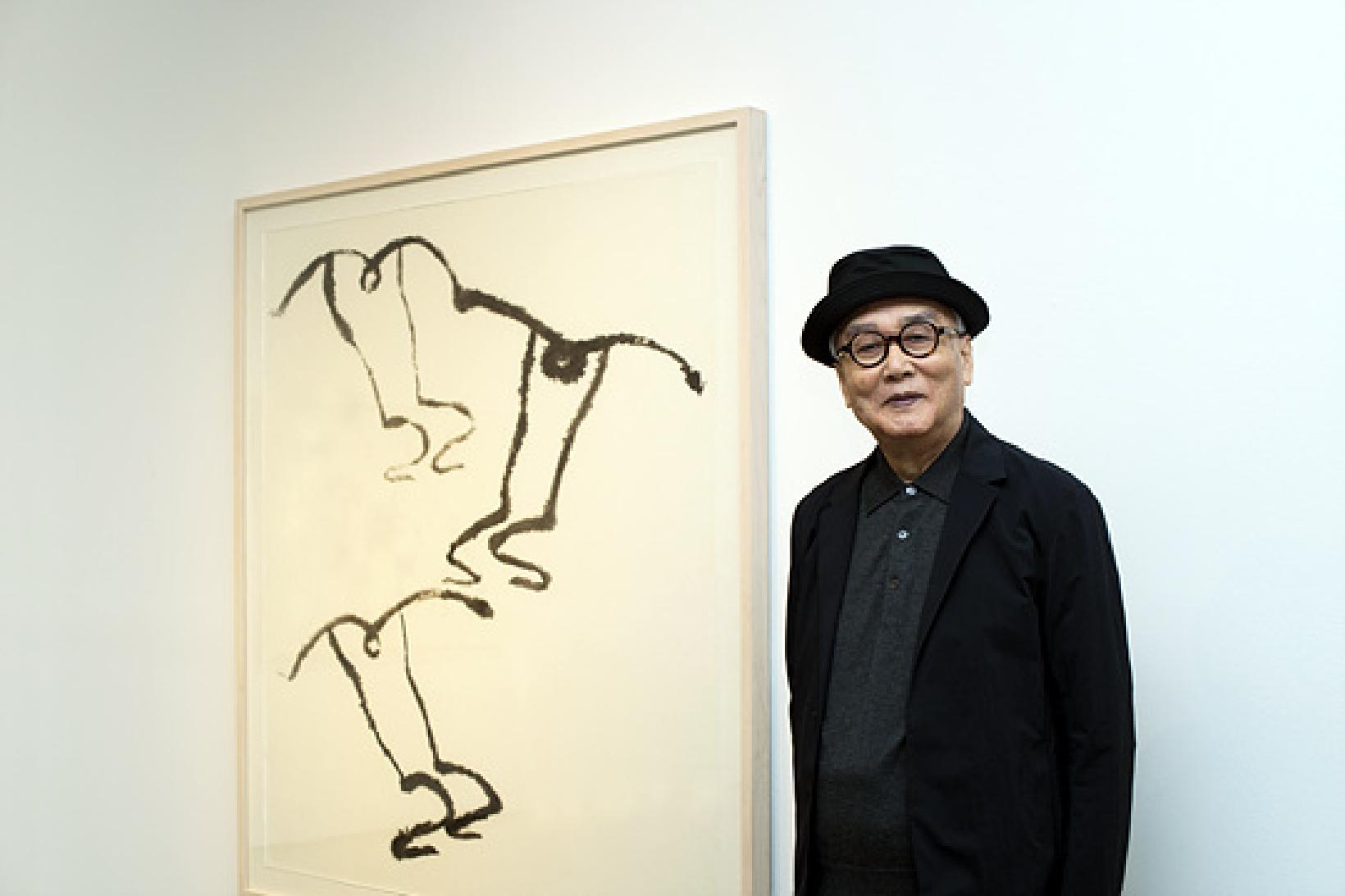Suh Se Ok (1929–2020) is a seminal figure not only an artist but professor and leader who continues his important artistic practice. As an artist and person coming of age in tumultuous times in Korean history, the artist strives to give the viewer the power to give meaning to his messages through their own active participation and engagement. As a scholar and philosopher, Suh’s works are imbued with an inheritance of literati painting, that is, derived from poetry, calligraphy, and scholarly texts, yet with novel adaptations into a new language that straddles the line between the abstract and the figurative With a practice that began in earnest in the 1940s and continues to this day, Suh enjoys an illustrious history despite having grown up in turbulent times in Korea’s history.
At the age of twenty, he won top prize in the inaugural Kukjon state run art exhibition in 1949. Soon thereafter the country would be engaged in a devastating war and this, of course, had its effects on the art in Korea. While art as a political tool is not a new thing, Suh refused to enter into the world of abstract expressionism to express freedom but rather stayed true to the medium of ink. It is this singular focus that expanded the notion of what ink painting would be all while seemingly independent of the contemporary art world machine and its inherent trappings. He formed the influential Ink Forest Society (“Mungnimhoe”) which sought to question preordained systems of art while also remaining committed to the medium. Their efforts also came of age with the younger generation’s desire to celebrate the individual and the expression of freedom for a generation having just lived through not only a brutal and destructive war but also under colonial occupation.
The power of his work is the totality of the composition with its deliberations on the void with the series of dots and lines providing an interplay between positive and negative space for his philosophical endeavors. Suh has explained that in the beginning, the universe had no boundaries just limitless energy when some person created the monumental act of creating a single mark – a dot. He believes this creation of the dot was of singular importance when it appeared in the untouched universe. The dot eventually evolved into another dot into another until it developed into a line which also left its trace in the universe. He explains the line is an evolving thing shifting and making turns to form a giant circle that no start or end to create a giant circle to form a single dot again which is how notions of form began in time and why the negative space is critical. Suh’s beautiful and important oeuvre of works are an important statement on art that not only embodied the Korean traditional but used this tradition to create a universal contemporary language.
Suh has held exhibitions at the National Museum of Modern and Contemporary Art, Seoul, Korea (2015, 2005); Museum of Fine Arts Houston, TX (2008); Leeum Samsung Museum of Art, Busan Biennale, Gyeonggi Museum of Art, Sao Paulo Biennial, and Maison Hermes, Tokyo, Japan (2007). His work are in the public collections of the British Museum, the Museum of Fine Art Houston, National Museum of Modern and Contemporary Art Korea, Leeum Samsung Museum of Art, Sonje Musum Gyeogju Korea, Rhode Island School of Design, Fukuoka Art Museum.
Accolades include the Order of Culture Merit Silver Medal (2012), The 52nd National Academy of Arts Award, Korea (2007), The Artistic and Culture Prize of 13th Federation of Artistic and Culture, Korea (1999), Ilmin Art Prize, Seoul, Korea (1994) and the Prime Minister Prize at the 1st National Art Exhibition (1949).
정통 동양화를 현대적으로 재해석하며 새로운 회화를 시도한 서세옥은 1960년대의 수묵 추상을 통해 한국미술의 현대화 운동에 앞장서며 한국 추상의 새로운 장을 열었고, 70년대 이후 일관되게 인간시리즈에 몰두했다. 대범한 붓질, 단순한 점과 선만으로 사람의 형상을 표현한 서세옥의 작품을 통해 인류의 희로애락을 엿볼 수 있다. 서정적인 추상계통의 동양화로 동양수묵의 무채담묵, 여백 공간의 강점만을 살려 현대적이며 독자적인 조형세계를 추구하는 작가이다. 서세옥의 기법과 매체는 표면상 단순해 보이지만, 먹을 통해 놀랍도록 다양한 흔적들을 만들어낸다. 1960년대의 작업들은 주로 흘림과 확산이라면, 7-80년대는 계획, 통제, 여백을 탐구하는 것에 매진했다. 서세옥의 그림 속 인간은 나이, 인종, 성별로 구분지을 수 없으며, 시간과 문화를 초월한다. 그들의 몸짓은 열린 해석을 가능하게 하다. 대형 한지에 커다란 붓으로 완성한 작품들은 다양한 비율, 두께, 농담淡)을 가진 일획과 선을 이용하여 인간을 표현한다. 그의 작품은 거침없이 그려진 듯 보이지만 이는 길고 긴 명상 후에 나온 결과물이다.
1929년 대구에서 태어난 서세옥은 1950년 서울대학교 미술대학 동양화과을 졸업하였다. 1949년 제1회 대한민국미술전람회에서 국무총리상을 수상하며 화단에 등단하였으며, 묵림회를 결성하여 동양화의 현대화에 앞장섰다. 작가는 미국 캘리포니아 퍼시픽 아시아 박물관, 대전시립미술관, 국립현대미술관 등 유수의 국내외 미술관에서 개인전을 열었으며, 1963년 상파울로비엔날레, 1969년 이탈리아 국제회화비엔날레와 프랑스 칸느 국제회화제 등 수많은 비엔날레에 참여하였다. 1955년부터 40년간 서울대학교 미술대학 교수로 재직한 서세옥은 1993년 국민훈장 석류장 수상, 2007년 대한민국예술원상, 2012년 은관문화훈장을 수상하였다.
